DOWNLOAD NEWS 2014/2
by Brian Wilson
Just when you thought you'd seen the back of me, I'm
putting together one last issue of Download News until my successor
can hit the ground running.
2014/1 is here and the index of earlier recordings is here.
Index for 2014/2 and earlier reviews mentioned therein:
BACH CPE Cantatas - Herrmann - Phoenix 2014/2
BACH CPE Hamburg Symphonies - Christ - Hänssler 2014/2
BACH CPE Keyboard Concertos Vol.20 - Spányi - BIS 2014/2
BACH CPE Magnificat, etc - Rademann - Harmonia Mundi 2014/2
BACH CPE Symphonies; Cello Concerto - Manze - Harmonia Mundi 2013/17
BEETHOVEN Missa Solemnis - Gardiner - SDG 2014/2
BEETHOVEN Missa Solemnis - Klemperer 1955 - Past Classics 2014/2
BRAHMS Piano Concertos 1 and 2 - Hough - Hyperion 2014/2
BRAHMS Piano Concertos 1 and 2 - Hough - Hyperion 2013/17
DAVY, SHEPPARD, MUNDY Voice of the Turtle Dove - Coro 2014/2: Recording of the Month
FALLA Amor brujo - Collins; Sombrero - Ansermet - Naxos
Archive 2014/2
FALLA El corregidor e la Molinera + LORCA - Pons - Harmonia Mundi
2014/2
FALLA Noches en los jardines - Soriano + RODRIGO -Beulah 2014/2
FALLA Noches en los jardines; Piano Music - Harmonia Mundi 2014/2
FALLA Sombrero de tres picos; Noches en los jardines - Harmonia
Mundi 2014/2
FERRANDINI Cantatas - Deuter - Accent 2014/2
GRAUPNER Cantatas - Feuersinger - Christophorus 2014/2
GRAUPNER Orchestral Suites - Finnish Baroque - Ondine 2014/2
HARDOUIN Masses - Krueger - Toccata 2014/2
La Lira d'Orfeo - see MONTEVERDI -Resonus 2014/2
LISZT Solo Piano Music - Cameron - Cala 2014/2 and 2013/16
LLOYD Symphonies - Downes - Lyrita 2014/2
LLOYD Symphonies - Lloyd - Albany 2014/2
LORCA Canciones antiguas + FALLA - Alvarez - Urtext 2014/2
LORCA Canciones antiguas + FALLA - Pons - Harmonia Mundi 2014/2
MACMILLAN World's Ransoming; Isobel Gowdie - Davis -LSO Live
2014/2: Freebie of the Month
MENDELSSOHN Symphonies 1, 3-5 - Litton - BIS 2014/2
MENDELSSOHN Symphonies 1-5, Overtures - Abbado - DG 2014/2
MENDELSSOHN Symphonies 3 and 4 - Karajan - DG June-09
MENDELSSOHN Symphonies 4 and 5 - Gardner - Chandos 2014/2
MENDELSSOHN Symphonies 4 and 5 - Krivine - Naïve Jun-09 and 2014/2
MENDELSSOHN Symphony 3; Hebrides - Klemperer - HDTT 2014/2
MENDELSSOHN Symphony 3; Hebrides - Maag - HDTT 2014/2
MENDELSSOHN Symphony 4 + BRAHMS - Boult - ICA 2013/4
MENDELSSOHN Symphony No.3 - Maag -Past Classics 2014/2
MINGUS Charles Complete recordings 1957-60 - Playtime 2014/2: Jazz
Bargain of the Month
MONTEVERDI etc La Lira di Orfeo - Pé - Resonus 2014/2
MUSSORGSKY Pictures + PROKOFIEV - Osborne - Hyperion 2014/2
NIELSEN Symphonies 4 and 5 - Oramo - BIS 2014/2
PROKOFIEV Visions Fugitives, Sarcasms + MUSSORGSKY -Hyperion
2014/2
RODRIGO Concierto de Aranjuez - Yepes + FALLA - Beulah 2014/2
SIBELIUS Violin Concerto, etc. Pike/Davis - Chandos 2014/2
SIBELIUS Violin Concerto, etc. Suwanai/Oramo - Japanese Decca 2012/23
STRAUSS R Salome - Schønwandt - Chandos 2014/2
STRAUSS R Salome - Solti - Decca/Hallmark 2014/2
VERESS Music for String Quartet - Basel Quartet - Toccata 2014/2
Recording of the Month
 The
Voice of the Turtle Dove
The
Voice of the Turtle Dove
John SHEPPARD (c.1515-58/9) Gaude, gaude, gaude Maria [14:08]
William MUNDY (c.1530-before 1591) Adolescentulus sum ego [5:35]
Richard DAVY (c.1465-c.1521) O Domine cæli terræque creator [14:41]
John SHEPPARD Libera nos I & II [6:28]
In manus tuas I [3:46]
Richard DAVY Ah, mine heart, remember thee well [4:57]
John SHEPPARD In manus tuas III [3:40]
William MUNDY Vox patris cælestis [17:37]
The Sixteen/Harry Christophers
pdf booklet with texts and translations included
CORO COR16119 [70:58] – from thesixteendigital.com (mp3, aac, 24/96 flac and alac)
 Despite
my admiration for The Tallis Scholars and other, newer groups in this
repertoire, or, rather, in addition to them, The Sixteen have strong
claims to this territory, too. To quote the blurb: ‘In 2014 The Sixteen
returns to its grass roots for the repertoire of the 14th Choral Pilgrimage
tour as it revisits the golden age of Renaissance polyphony in England.’
My only complaint is that almost all of the music has already featured
in earlier recordings by The Sixteen.
Despite
my admiration for The Tallis Scholars and other, newer groups in this
repertoire, or, rather, in addition to them, The Sixteen have strong
claims to this territory, too. To quote the blurb: ‘In 2014 The Sixteen
returns to its grass roots for the repertoire of the 14th Choral Pilgrimage
tour as it revisits the golden age of Renaissance polyphony in England.’
My only complaint is that almost all of the music has already featured
in earlier recordings by The Sixteen.
The oldest music here, by Richard Davy, O Domine … creator and Ah mine heart appeared on The Pillars of Eternity,
Volume III of The Sixteen’s 5-disc survey of music from the Eton Choirbook
(COR16022). Both pieces are taken slightly faster than before
but otherwise there is little to choose. I must take this opportunity
to direct you to those wonderful recordings of the music from the Eton
Choirbook and to express the hope that thesixteendigital.com will make
them available in lossless download form – good as the 320kb/s downloads
are from classicsonline.com.
There are also earlier Sixteen recordings of the music of John Sheppard,
made some time ago for Hyperion (2-for-1 CDD22022 or in 10-CD box, The Golden Age, CDS44401/10 – review and review: Bargain of the Month) and more recently for their own
Coro label. In the case of those works included in the Hyperion set,
Harry Christophers adopts slightly slower tempi than before but, once
again, there is very little to choose. The download of the 10-CD set
is currently discounted at £26.25, so it’s a superb bargain even if
you also choose the new album.
The Sixteen also recorded the two Mundy works for Hyperion on an album
entirely devoted to that unjustly neglected composer: CDH55086 (budget price) or in the 10-CD set listed above. There is little to
choose between the two versions of Vox patris cælestis but Adolescentulus sum ego is now taken decidedly faster than before,
yet still given time to breathe. I’d still go for The Tallis Scholars
in Vox patris cælestis, from the very first recording of theirs
that I encountered, coupled with the Allegri Miserere and Palestrina Missa Papæ Marcelli, available very inexpensively on their
25 th Anniversary Album GIMSE401.
The Sixteen pace it beautifully but The Tallis Scholars give it that
little extra room to breathe and for that reason I marginally prefer
them to The Sixteen and even to their own remake on Live in Oxford (CDGIM998).
Whichever version you choose, the music deserves to be more widely known.
I awarded the Recording of the Month accolade for the
sheer delight of this new compilation, despite my misgivings about the
duplication of material.
Both thesixteendigital.com and gimell.com have reissued their recordings
of Sir John Tavener’s (1944-2013) Ikon of Light, with
The Sixteen and The Tallis Scholars respectively:COR16116 and GIMSE404 (both in mp3, aac and 16/44.1 lossless formats). The Coro is available
now; the Gimell, at budget price, is due at the end of March 2014 but
can be previewed as CDGIM005 by streaming from Naxos Music Library.
La Lira di Orfeo - A Tribute to Gualberto Magli
Claudio MONTEVERDI (1567-1643) L’Orfeo – Musica (Prologo)
– Primo intermezzo –
Speranza (from Act III) – Possento Spirito – Prosperina (from Act IV) [13:42]
Johann NAUWACH (1595-1630) Amarilli mia bella [3:37]
Francesca CACCINI (1587-c.1645) Dispiegate guancie amate [2:34]
Giulio CACCINI (1550-1618) Sfogava con le stele [2:31]
Sigismondo D’INDIA (c.1582 - 1629) Ancidetemi pur, dogliosi
affani (Lamento di Giasone) [7:5]
Francesco LAMBARDI (1587-1642 ) O felice quel giorno [2:40]
Giovanni TRABACI (c.1575-1647) Toccata Seconda per l’arpa [2:39]
Girolamo MONTESARDO (1580-1620) Hor che la nott’ombrosa [3:04]
Alessandro CICCOLINI Solo et pensoso [7:27]
Giovanni Camillo Di PRIMI Se fama al mondo [2:11]
Johann NAUWACHTempesta di dolcezza [1:51]
Jetzund kömpt die Nacht herbey [4:21]
Sigismondo D’INDIAPiangono al pianger mio [3:10]
Raffaele Pé (counter-tenor)
Chiara Granata (triple harp – arpa doppia)
David Miller (theorbo) – rec. June/July 2013. DDD
pdf booklet with texts and translations included
RESONUS CLASSICS RES10124 [56:59] – from resonusclassics.com (mp3, aac, 16- and 24-bit lossless) or eclassical.com (mp3, 16- and 24-bit lossless) or stream from Naxos Music Library. No
CD equivalent.
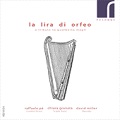 Though
billed as featuring Orpheus’s lyre, the cover illustration shows a 3-string
harp, as employed for the principal accompaniment here. Actually, there’s
so little difference between the harp and lyre that the instrument discovered
in an Anglo-Saxon burial mound at Sutton Hoo and displayed in the British
Museum, was originally reconstructed as a harp and only later turned
out to be a lyre. In any case the prime raison d’être for this
release is to showcase the voice of Raffele Pé, who, as I’m quoted in
the booklet as saying of an earlier release, ‘is a discovery, indeed,
a challenge to the likes of Andreas Scholl and Philippe Jaroussky.’
Though
billed as featuring Orpheus’s lyre, the cover illustration shows a 3-string
harp, as employed for the principal accompaniment here. Actually, there’s
so little difference between the harp and lyre that the instrument discovered
in an Anglo-Saxon burial mound at Sutton Hoo and displayed in the British
Museum, was originally reconstructed as a harp and only later turned
out to be a lyre. In any case the prime raison d’être for this
release is to showcase the voice of Raffele Pé, who, as I’m quoted in
the booklet as saying of an earlier release, ‘is a discovery, indeed,
a challenge to the likes of Andreas Scholl and Philippe Jaroussky.’
I suppose it was too much to expect more than excerpts from Monteverdi’s L’Orfeo, especially in the light of the recent release on Avie
of a fine new recording of that work from a team headed by Andrew Parrott.
One day, however, I hope that Pé gets the chance to record the complete
work. Meanwhile he shines as brightly as on that earlier Resonus album.
Christoph GRAUPNER (1683-1760) Orchestral Suites
Suite in F for transverse flute, viola d’amore, 2 chalumeaus, baroque
horn, strings and cembalo, GWV451 [20:49]
Overture in F, GWV 450 [25:18]
Suite in G for viola d’amore, bassoon, strings and cembalo, GWV458 [29:53]
Finnish Baroque Orchestra/Sirkka-Liisa Kaakinen-Pilch – rec. May 2013.
DDD
pdf booklet included
ONDINE ODE1220-2 [76:00] – from eclassical.com (mp3 and loss)
Christoph GRAUPNER
Cantata GWV1145/11 ‘Angst und Jammer’* [19:08]
Overture in c minor, GWV413: Tombeau* [2:52]
Cantata GWV1102/11b ‘Furcht und Zagen’* [14:42]
Cantata GWV1106/19 ‘Ich bleibe Gott getreu’* [16:46]
Cantata GWV1144/11 ‘Ach Gott und Herr’ [22:38]
Miriam Feuersinger (soprano); with guest Xenia Löffler (baroque oboe)
Capricornus Consort Basel/Peter Barczi (violin) – rec. April/May 2013.
DDD
* world premiere recordings
pdf booklet with texts included – no translations.
CHRISTOPHORUS CHR77381 [76:06] – from eclassical.com (mp3 and lossless)
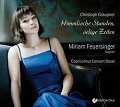
 Christoph
Graupner was the Leipzig council’s first choice for the job of Kantor
at the Thomaskirche but his employers refused to let him go, so the
‘second-best’ Johann Sebastian Bach was chosen and the rest is history
– but not quite because history has been undeservedly unkind to the
memory of Graupner. Three of the cantatas and the overture on the Christophorus
album are receiving their world premiere recordings. His works have
now been catalogued – every good German composer needs a WV number –
and the record companies are gradually putting right the neglect. These
two well-filled recordings should serve that purpose very well.
Christoph
Graupner was the Leipzig council’s first choice for the job of Kantor
at the Thomaskirche but his employers refused to let him go, so the
‘second-best’ Johann Sebastian Bach was chosen and the rest is history
– but not quite because history has been undeservedly unkind to the
memory of Graupner. Three of the cantatas and the overture on the Christophorus
album are receiving their world premiere recordings. His works have
now been catalogued – every good German composer needs a WV number –
and the record companies are gradually putting right the neglect. These
two well-filled recordings should serve that purpose very well.
Mark Sealey has already sung the praises of the Ondine recording – review – and I’m happy to concur. The downloaded recording is good – 16-bit
only, though I see that the original was recorded in 24-bit sound –
and the fine booklet comes as part of the deal.
I hardly thought to hear a voice that challenges and in some respects
excels that of Emma Kirkby for clarity and beauty of tone, but Miriam
Feuersinger does just that on the cantata recording. I have only one
grumble about this album, that the tonal beauty is not matched by clarity
of diction; I tried to listen without the booklet of texts to hand and
could hardly make out a single word, perhaps as a result of the slightly
resonant recording. Those whose German is rusty will have a problem
even with the booklet because there are no translations. As if to prove
that it can be done, the opening words of Ich bleibe Gott getreu are beautifully clear. For the rest, the booklet provides the texts
in German but no translations.
Don’t expect cantatas on the Bach model – if you know Telemann’s cantatas
for solo voice, for example as recorded by Toccata, these are more akin
to that type. Otherwise I have only praise for the quality of the music,
performances, recording and lossless download. In the booklet Ms. Feuersinger
thanks all concerned but most of all Graupner himself for the pleasure
of discovering his music: Der Schlussdank geht an Christoph Graupner,
dessen Kantaten zu entdecken ein sehr schönes und tiefgreifendes Erlebnis
für mich war. Conversely the spirit of Graupner owes a debt of
thanks to her and all who have contributed to this recording.
Giovanni Domenico FERRANDINI (1709-1791) Cantate drammatiche
Sinfonia Pastorale [1:32]
Cantata No. 1 [12:32]
Cantata No. 3 [20:00]
Sinfonia in B flat [5:15]
Cantata No. 4 [22:50]
Olivia Vermeulen (mezzo)
Harmonie Universelle/Florian Deuter – rec. December 2010. DDD
ACCENT ACC24277 [62:31] – from eclassical.com (mp3 and lossless, no booklet) or stream from Naxos Music Library (with
pdf booklet)
 This
is new ground for me – the only music by Ferrandini that I’d heard before
is his Pianto di Maria, once attributed to Handel* – and it’s
ground covered in an attractive manner in this recording, which appears
to be available, in the UK at any rate, as a download only. Two of these
cantatas are on the old theme of powerful, unrequited love, while No.3
features the sunflower defending its attractions against the more showy
flowers of the field.
This
is new ground for me – the only music by Ferrandini that I’d heard before
is his Pianto di Maria, once attributed to Handel* – and it’s
ground covered in an attractive manner in this recording, which appears
to be available, in the UK at any rate, as a download only. Two of these
cantatas are on the old theme of powerful, unrequited love, while No.3
features the sunflower defending its attractions against the more showy
flowers of the field.
All three cantatas recorded here, indeed all six in the collection,
are for solo voice, in this case for mezzo. Though beautifully sung
by Olivia Vermeulen and with two short Sinfonias interspersed
for a degree of variety, there is an element of sameness throughout,
especially as the music is not quite as dramatic as the overall title
implies.
With six violins listed among the personnel, Harmonie Universelle would
seem on paper to be a little on the large side for a chamber ensemble
but in practice the accompaniment is of just the right proportions.
The lossless recording is good but the lack of a booklet of texts from
eclassical.com reduces the appeal. Fortunately subscribers to Naxos
Music Library can sample the music there and obtain the booklet of notes
– slightly awkwardly translated into English – texts and translations.
* sung by Bernarda Fink on Decca Oiseau-Lyre 4781466 – review.
Carl Philipp Emanuel BACH (1714-1788)
Sinfonia in G, Wq. 182/1, H. 657 [10:41]
Sinfonia in B-Flat, Wq. 182/2, H. 658 [10:35]
Sinfonia in C, Wq. 182/3, H. 659 [11:39]
Sinfonia in A, Wq. 182/4, H. 660 [12:25]
Sinfonia in b minor, Wq. 182/5, H. 661 [10:51]
Sinfonia in E, Wq. 182/6, H. 662 [9:08]
Stuttgart Chamber Orchestra/Wolfram Christ – rec. February 2013. DDD.
pdf booklet included
HÄNSSLER CLASSIC CD98.637 [65:29] – from classicsonline.com (mp3) or stream from Naxos Music Library
 If
you are new to the Hamburg Symphonies of C.P.E. Bach, as was I before
I heard this recording, you’re in for a real treat. Composed in 1773
for Gottfried van Swieten, the Austrian ambassador in Prussia who later
sponsored Haydn, Mozart, and Beethoven, these works abound in interesting
melodies and are simply delightful.
If
you are new to the Hamburg Symphonies of C.P.E. Bach, as was I before
I heard this recording, you’re in for a real treat. Composed in 1773
for Gottfried van Swieten, the Austrian ambassador in Prussia who later
sponsored Haydn, Mozart, and Beethoven, these works abound in interesting
melodies and are simply delightful.
The performances by the Stuttgart Chamber Orchestra under the direction
of Wolfram Christ (former principal violist of the Berlin Philharmonic)
are fresh and ebullient. Tempos in the outer movements are swift, and
slow movements never lag. Playing and ensemble are crisp and tight.
Unique here is the decision to use a fortepiano for the continuo part,
which provides a fuller yet less invasive sounding accompaniment than
the typical harpsichord. I found nothing lacking in the sound quality
of the mp3 version, which is both clear and dynamic, though the 16-bit
lossless recording can be found at eclassical.com and prestoclassical.co.uk.
Outstanding.
Albert Q. Lam
I’m happy to endorse Albert Lam’s high opinion of this recording – and
to point out that it sounds even better in lossless format from eclassical.com.
If CPE’s music appeals – and it’s a good deal more interesting and unpredictable
than is often said – there’s a very good recording to follow up by the
English Concert and Andrew Manze of the symphonies Wq.183/1-4 with a
Cello Concerto (HMU807403 – DL
News 2013/17).
 I’ve
enjoyed several releases in the BIS series of CPE Bach’s keyboard concertos.
The latest, final volume (No.20: BIS-CD-1967 – rec. 2012) includes
the double concertos Wq.47 (H479) and 46 (H408) and the Sonatina Wq.109
(H543). Miklós Spányi plays a modern copy of a 1745 harpsichord, is
accompanied by Concerto Armonico Budapest and the album is available
in mp3, 16- and 24-bit sound from eclassical.com.
The other soloists are Tamás Szekendy (fortepiano, Wq.47, establishing
a very effective contrast between the two keyboard solos) and Cristiano
Holtz (harpsichord, Wq.46 and 109) and Péter Szüts conducts the Sonatina.
As before there’s a helpful set of notes.
I’ve
enjoyed several releases in the BIS series of CPE Bach’s keyboard concertos.
The latest, final volume (No.20: BIS-CD-1967 – rec. 2012) includes
the double concertos Wq.47 (H479) and 46 (H408) and the Sonatina Wq.109
(H543). Miklós Spányi plays a modern copy of a 1745 harpsichord, is
accompanied by Concerto Armonico Budapest and the album is available
in mp3, 16- and 24-bit sound from eclassical.com.
The other soloists are Tamás Szekendy (fortepiano, Wq.47, establishing
a very effective contrast between the two keyboard solos) and Cristiano
Holtz (harpsichord, Wq.46 and 109) and Péter Szüts conducts the Sonatina.
As before there’s a helpful set of notes.
Now I must catch up with some of the earlier volumes that I’ve missed.
There’s a 2-CD set of CPE’s vocal works:
Morgengesang am Schöpfungsfeste , Wq.239, H.779 [12:00]
Weihnachts-Musik: Auf schicke dich , Wq.249, H.815[18:03]
Anbetung dem Erbarmer , Wq.243, H.807 [20:41]
Heilig (Te Deum), Wq.217, H.778 [7:18]
Herrn Pastors Gasie Einführungsmusik , Wq. 250, H.821[25:39]
Wer ist so würdig als du , Wq.222, H.831 [4:56]
Der Herr lebet , Wq.251, H.821g [36:18]
Barbara Schlick (soprano); Rheinische Kantorei; Das kleine Konzert/Max
Herrmann
PHOENIX453 [2:04:55] – from eclassical.com (mp3 and lossless) Also available on CD, Brilliant Classics 94817.
 No
recording dates are given, though I think these have been round the
block before. They’re part of a series recorded by Capriccio for the
bicentenary of his death in 1988 and reissued for the tercentenary of
his birth. There are no texts or translations, though you should find
Klopstock’s Creation Ode, the text of the first cantata, easily
enough online: try http://www.freidok.uni-freiburg.de/volltexte/6315/pdf/Morgengesang.pdf
No
recording dates are given, though I think these have been round the
block before. They’re part of a series recorded by Capriccio for the
bicentenary of his death in 1988 and reissued for the tercentenary of
his birth. There are no texts or translations, though you should find
Klopstock’s Creation Ode, the text of the first cantata, easily
enough online: try http://www.freidok.uni-freiburg.de/volltexte/6315/pdf/Morgengesang.pdf
The music and the performances are attractive and the recording still
sounds well. Whatever new recordings of CPE we get in this tercentenary
year are not likely to put this too much in the shade.
CPE Bach’s Magnificat, Wq215, is written in a style akin to his
father’s music, not surprisingly since its first performance in 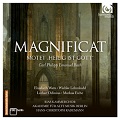 Leipzig
seems to have been intended as a bid to succeed his father as Thomaskantor.
For that reason it has sometimes made a good companion for JS Bach’s Magnificat, and it doesn’t fall far short of the latter – both
were intended for those high days when the Latin text was sung rather
than the German paraphrase. A new Harmonia Mundi recording couples it
with the short but striking motet Heilig ist Gott, Wq217, (a
paraphrase of the Te Deum), and the Sinfonia in D, Wq183: Elizabeth
Watts (soprano), Wiebke Lehmkuhl (alto), Lothar Odinius (tenor) and
Markus Eiche (bass); RIAS Kammerchor, Akademie für alte Musik, Berlin/Hans-Christoph
Rademann. (HMC902167 [55:30] – from eclassical.com as HM2167D in mp3, 16- and 24-bit lossless, with pdf booklet
containing texts and translations).
Leipzig
seems to have been intended as a bid to succeed his father as Thomaskantor.
For that reason it has sometimes made a good companion for JS Bach’s Magnificat, and it doesn’t fall far short of the latter – both
were intended for those high days when the Latin text was sung rather
than the German paraphrase. A new Harmonia Mundi recording couples it
with the short but striking motet Heilig ist Gott, Wq217, (a
paraphrase of the Te Deum), and the Sinfonia in D, Wq183: Elizabeth
Watts (soprano), Wiebke Lehmkuhl (alto), Lothar Odinius (tenor) and
Markus Eiche (bass); RIAS Kammerchor, Akademie für alte Musik, Berlin/Hans-Christoph
Rademann. (HMC902167 [55:30] – from eclassical.com as HM2167D in mp3, 16- and 24-bit lossless, with pdf booklet
containing texts and translations).
This arrived as I was closing the DL News, so I haven’t had time for
comparisons. There’s not much competition in the current catalogue –
and two of the competitors are bound up in 10- and 30-disc boxes – but
the new recording will do very well indeed.
Henri HARDOUIN (1727-1808) Four-Part Masses, Volume One
Mass No. 1, Incipite Domino in tympanis (publ. 1772) [17:47]
Mass No. 3, Jucundum sit eloquium meum (publ. 1772) [23:36]
Mass No. 4, Exaltate et invocate nomen ejus (publ. 1772) [19:00]
St Martin’s Chamber Choir/Timothy J. Krueger – rec. DDD.
first recordings
pdf booklet with texts and translations included
TOCCATA CLASSICS TOCC191 [60:38] – from toccataclassics.com or eclassical.com (both mp3 and lossless) or stream from Naxos Music Library
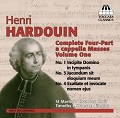 Once
again we owe Toccata our thanks for rescuing neglected music, this time
by a French priest-composer whose works could not be performed during
the first phase of the Revolution between 1791 and 1794. These are premiere
recordings and they are promised as the first volume, with three other
masses yet to come. The a cappella settings are short and fairly
simple and conservative in style – don’t expect anything to match Haydn
or Mozart, though the brevity would have delighted the latter’s employer,
Archbishop Colloredo – but the music is nonetheless attractive and the
performances and recording do it justice.
Once
again we owe Toccata our thanks for rescuing neglected music, this time
by a French priest-composer whose works could not be performed during
the first phase of the Revolution between 1791 and 1794. These are premiere
recordings and they are promised as the first volume, with three other
masses yet to come. The a cappella settings are short and fairly
simple and conservative in style – don’t expect anything to match Haydn
or Mozart, though the brevity would have delighted the latter’s employer,
Archbishop Colloredo – but the music is nonetheless attractive and the
performances and recording do it justice.
The titles of the masses suggested to me, as to the author of the notes
in the booklet, that Hardouin was employing a cantus firmus technique,
using tunes perhaps peculiar to the local Rheims usage, but the modern
editor of the music suggests instead that the titles, from the Breviary
readings from Judith and Psalms, rather suggest appropriateness to a
particular Sunday or feast day, though I’m not sure how that works out,
since traditionally the canticle from Judith 16, quoted in the titles
of Masses 1 and 3, was traditionally assigned to Wednesday Lauds.
Ludwig van BEETHOVEN (1770-1827)
Missa Solemnis in D, Op. 123 [70:04]
Lucy Crowe (soprano), Jennifer Johnston (mezzo), James Gilchrist (tenor),
Matthew Rose (bass)
Monteverdi Choir,
Orchestre Révolutionnaire et Romantique/Sir John Eliot Gardiner – rec.
live at the Barbican Hall, London, October 2012. DDD.
pdf booklet with texts included
SOLI DEO GLORIA SDG718 [70:04] – from eclassical.com (mp3 and lossless)
 (Recording
of the Month – see review by John Quinn)
(Recording
of the Month – see review by John Quinn)
I passed this by when it was released, thinking that not even Sir John
Eliot Gardiner could surpass his own DG recording, my clear favourite
among earlier versions. John Quinn’s review and others in similarly
adulatory vein persuaded me to listen – and I was convinced.
I’m not going to dispose of my CD of the earlier Gardiner recording,
but the new one will, I’m sure, be in my listening schedule just as
often.
 There’s
one other recording that I must mention with strong approval: between
Otto Klemperer’s 1951 classic Vox account and his more monumental EMI
Classics version, WDR recorded him in Cologne in 1955 and this recording
is available inexpensively on Past Classics – just £2.10 from emusic.com and only a little more from other download sites. There has been considerable
speculation about the provenance of this recording, with some attributing
the direction to Josef Krips, but it seems to have been Klemperer at
the helm of the Kölner Rundfunk-Orchester, with some fine soloists.
Past Classics don’t name them but they seem to have been Anneliese Kupper,
Sieglinde Wagner, Rudolf Schock and Josef Greindl. The timings (total
74:51) closely match the Medici Masters CD which reliably claims to
be of Klemperer in 1955, allowing for slightly longer run-in and -out
times on the latter, but I responded much more positively to the Past
Classics transfer than John Sheppard did to the Medici Masters – review.
There’s
one other recording that I must mention with strong approval: between
Otto Klemperer’s 1951 classic Vox account and his more monumental EMI
Classics version, WDR recorded him in Cologne in 1955 and this recording
is available inexpensively on Past Classics – just £2.10 from emusic.com and only a little more from other download sites. There has been considerable
speculation about the provenance of this recording, with some attributing
the direction to Josef Krips, but it seems to have been Klemperer at
the helm of the Kölner Rundfunk-Orchester, with some fine soloists.
Past Classics don’t name them but they seem to have been Anneliese Kupper,
Sieglinde Wagner, Rudolf Schock and Josef Greindl. The timings (total
74:51) closely match the Medici Masters CD which reliably claims to
be of Klemperer in 1955, allowing for slightly longer run-in and -out
times on the latter, but I responded much more positively to the Past
Classics transfer than John Sheppard did to the Medici Masters – review.
The singing is excellent, the scale of the performance just right and
the recording, though edgy and resolutely double-mono, is clear and
free from distortion even in loud passages, albeit that the emusic.com
transfer is at a miserly 160kb/s.
Mendelssohn in Birmingham – Volume 1
Felix MENDELSSOHN (1809-1847)
The Hebrides Overture, Op. 26 [9:51]
Symphony No. 5 in D, Op. 107 Reformation [27:40]
Symphony No. 4 in A, Op. 90 Italian [28:12]
City of Birmingham Symphony Orchestra/Edward Gardner – rec. October
2013. DDD/DSD
CHANDOS CHAN5132 [66:04] – from theclassicalshop.net (mp3, 16- and 24-bit lossless). Also available as hybrid SACD CHSA5132.
Comparative versions of Mendelssohn symphonies:
• Symphonies 1-5; Overtures: DG 471467-2 (4 CDs)
LSO and Chorus/Claudio Abbado – from amazon.co.uk (mp3)
• Nos. 3 and 4 only from 7digital.com (mp3), or 4 and 5 only from 7digital.com (mp3).
• Symphonies 1 and 4; Ruy Blas Overture: BIS-SACD-1584 Bergen PO/Andrew Litton – from eclassical.com (mp3, 16- and 24-bit lossless) – review.
• Symphonies 3 and 5: BIS-SACD-1604 Bergen PO/Andrew
Litton – from eclassical.com (mp3, 16- and 24-bit lossless) Recording of the Month – review.
• Symphony No.3: PAST TIMES LSO/Peter Maag – from emusic.com (mp3)
• Hebrides Overture; Symphony No.3: HDDL315 Philharmonia Orchestra/Otto Klemperer – from High
Definition Tape Transfers (24/96 and 24/192 lossless). pdf booklet
included.
• Symphonies 3 and 4; The Hebrides: DG Originals
4497432 BPO/Herbert von Karajan – from 7digital.com - June
2009 DL Roundup
• Symphony No.4: ICA ICAC5093 RPO/Sir Adrian Boult
(with BRAHMS Symphony No.4) – review and DL
News 2013/4
• Symphonies 4 and 5: NAÏVE V5069 La Chambre Philharmonique/Emmanuel
Krivine – review and June
2009 DL Roundup
• Symphonies 4 and 5: Philips 4224702 (no longer
available separately) NPO/Wolfgang Sawallisch
The arrival of the new Chandos recording and the death of Claudio Abbado
prompted me to look at recordings of all the Mendelssohn symphonies.
Among those listed above there’s nary a dud to be found, so the new
recording has its work cut out. Even its availability as an SACD and
in 24-bit download format is not unique, as that applies also to the
two BIS/Litton recordings, albeit that they were recorded at 44.1kHz.
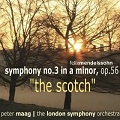
 The Maag recording, from 1960, is the oldest of those listed. Though
the emusic.com download is at a disgracefully low bit-rate of around
150kb/s, it sounds well enough, albeit with some moments of strain in
loud passages and it’s very light on stereo placement. Despite the fact
that it’s very inexpensive at £0.84 or less it’s a safer buy on mid-price
CD (Decca E4669902) or as a download in mp3 or lossless flac, Mendelssohn in Scotland, Decca 4783184, from prestoclassical.co.uk.
Both couple music from A Midsummer Night’s Dream.
The Maag recording, from 1960, is the oldest of those listed. Though
the emusic.com download is at a disgracefully low bit-rate of around
150kb/s, it sounds well enough, albeit with some moments of strain in
loud passages and it’s very light on stereo placement. Despite the fact
that it’s very inexpensive at £0.84 or less it’s a safer buy on mid-price
CD (Decca E4669902) or as a download in mp3 or lossless flac, Mendelssohn in Scotland, Decca 4783184, from prestoclassical.co.uk.
Both couple music from A Midsummer Night’s Dream.
Maag’s Scottish Symphony originally came with The Hebrides Overture but the Past Times download has been shorn of what was an appropriate
coupling which remains available on a 2-CD budget set from Decca Eloquence
(4803483). This recording set a high standard for many years
until Decca capped their own achievement with a recording featuring
the LSO and Claudio Abbado (mid-price Decca Originals 4758677:
download for £4.99 from 7digital.com).
There’s also a recent 24-bit audiophile transfer of Maag’s Hebrides and Symphony No.3 from HDTT (HDDL414 – here)
of which I was sent only the Hebrides for review. That track
sounds very well indeed – much better than the Past Classics version
of the symphony and slightly brighter than the HDTT Klemperer (below)
and slightly faster-paced. Both these HDTT transfers are available in
24/96 and 24/192; be aware that the latter are very large files indeed
and not all DACs can cope with them – my own Dragonfly will play 24/192
but only by downsizing to 24/96, which rather defeats the object of
paying more and taking four times as long to download.

Klemperer’s recording of the Third Symphony and Hebrides dates from the same year as the Maag. If you thought of Klemperer as
a slouch, this should make you think again: he gives the overture time
to breathe but he’s only seconds slower than Maag and slightly faster
than Abbado. In the first movement of the Scottish symphony,
too, his tempo falls between Maag and Abbado – very little between them
again – and in the third movement he’s actually slightly faster than
either.
The 1960 recording has come up extremely well in this HDTT transfer,
without any of the artificial brightness that they sometimes apply,
so I was delighted to make the acquaintance of this recording again.
There’s something odd about the booklet, which switches abruptly from
describing the symphony to a description of Act II of Giselle.
 There’s
another vintage (1952) Decca recording of this symphony from Solti on
Beulah 4-6BX16 – DL
Roundup November 2010. I enjoyed it but it’s somewhat outshone as
performance and recording by Maag and I’d hardly make it an urgent recommendation.
There’s
another vintage (1952) Decca recording of this symphony from Solti on
Beulah 4-6BX16 – DL
Roundup November 2010. I enjoyed it but it’s somewhat outshone as
performance and recording by Maag and I’d hardly make it an urgent recommendation.
Karajan’s recording from 1971 sounds much fuller than the Past
Classics Maag. It offers the classic coupling of the Scottish and Italian symphonies plus The Hebrides in performances
that still deserve to be ranked with the very best and, at £4.99 from
7digital.com, it’s good value, too.
You may have to re-number the tracks to get them to play in the right
order.
If it’s just those two works that you want, the choice is between this
and the other DG recording listed above, taken from the 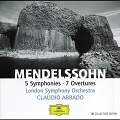 complete
DG/Abbado set.
complete
DG/Abbado set.
If you plan to buy either of the single-album DG/Abbado recordings,
however, you should bear in mind the availability of the complete 4-CD
set from Amazon for just a little extra - £9.99 in the UK for all five
symphonies plus the overtures. The bit-rate is lower than 7digital.com’s
320kb/s, at around 250kb/s, but the DDD recording comes over well in
this transfer and the set reminds us that there’s more to Mendelssohn
than just the three best-known symphonies.
The Boult recording of the Italian Symphony comes with a version
of Brahms’ No.4 that challenges – but doesn’t replace –  Klemperer’s
version of that work in my esteem.
Klemperer’s
version of that work in my esteem.
His Mendelssohn may not be quite so special but it’s well worth having
for the sake of the Brahms. The download from eclassical.com comes in mp3 and lossless flac and at a price that makes it competitive
with other download sites who offer it in mp3 only.
 At
one time I might have had to make a case for No.5, the Reformation Symphony, but that work has become more popular in recent years. Sawallisch’s 1966 recording of 4 and 5 still finds a regular place in my listening
schedule, alongside his Elijah (in German). Both of these are
now entombed in a budget-price 14-CD Decca set, along with the other
three symphonies (Decca 4807707, around £40) but you may be able
to find copies of the single CD of the Italian and Reformation symphonies and the Philips Duo of Elijah. The five symphonies
from Sawallisch are also available in a budget-price Brilliant Classics
set along with the String Symphonies (93777, 7 CDs for
around £19, Bargain of the Month – review).
At
one time I might have had to make a case for No.5, the Reformation Symphony, but that work has become more popular in recent years. Sawallisch’s 1966 recording of 4 and 5 still finds a regular place in my listening
schedule, alongside his Elijah (in German). Both of these are
now entombed in a budget-price 14-CD Decca set, along with the other
three symphonies (Decca 4807707, around £40) but you may be able
to find copies of the single CD of the Italian and Reformation symphonies and the Philips Duo of Elijah. The five symphonies
from Sawallisch are also available in a budget-price Brilliant Classics
set along with the String Symphonies (93777, 7 CDs for
around £19, Bargain of the Month – review).
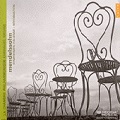
Krivine with his period-instrument players casts new light on
these two symphonies. It’s not just the faster tempi that make the difference;
these lithe performances will be ideal for many listeners. Emusic.com
is the least expensive way to obtain this recording but at a fairly
low bit-rate; classicsonline.com give you 320kb/s mp3 for only a little more (£4.99).
For all the enjoyment Krivine delivers, it’s the Abbado, Litton and
Sawallisch versions of Nos. 4 and 5 and Karajan in No. 4, with modern
instruments that I’ve used as my benchmarks for the new Chandos recording.
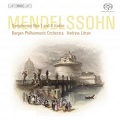
 Litton on BIS has received some very mixed responses from MusicWeb International
reviewers: Nos. 1, 2 and 4 were not liked but Dominy Clements made Nos. 3
and 5 a Recording of the Month – review.
Stephen Francis Vasta’s judgement on No.1 as phlegmatic and on No.4
as featuring generalised and diffuse playing – review – surprised me in view of the positive reviews which this recording
has received elsewhere, so I listened with apprehension to the BIS download.
You may not be too startled to learn that, there being no accounting
for taste – de gustibus, etc – I couldn’t find much amiss here
and enjoyed the pairing of the 1833 work with its teenage predecessor
of 1824.
Litton on BIS has received some very mixed responses from MusicWeb International
reviewers: Nos. 1, 2 and 4 were not liked but Dominy Clements made Nos. 3
and 5 a Recording of the Month – review.
Stephen Francis Vasta’s judgement on No.1 as phlegmatic and on No.4
as featuring generalised and diffuse playing – review – surprised me in view of the positive reviews which this recording
has received elsewhere, so I listened with apprehension to the BIS download.
You may not be too startled to learn that, there being no accounting
for taste – de gustibus, etc – I couldn’t find much amiss here
and enjoyed the pairing of the 1833 work with its teenage predecessor
of 1824.
One strange thing about this recording of the Italian concerns
timings, especially for the finale. The booklet, like Naxos Music Library
and eclassical.com, states 5:31 – about in line with the consensus for
this movement – but Winamp times the 24-bit lossless and Windows Media
Player the mp3 version at a much slower 6:03, reflecting a most unusual
run-out of 30 seconds.
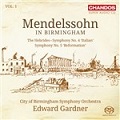 The
new Gardner recording is billed as Volume 1 of Mendelssohn
in Birmingham – a city where much of his music was performed, so
the title is no mere gimmick. It opens with The Hebrides as an hors d’œuvre. It’s a bit slow to get under way; though the overall
tempo is about par for the course, I prefer something that opens with
a little more zip, such as the vintage Beinum on Beulah 10BX37.
The
new Gardner recording is billed as Volume 1 of Mendelssohn
in Birmingham – a city where much of his music was performed, so
the title is no mere gimmick. It opens with The Hebrides as an hors d’œuvre. It’s a bit slow to get under way; though the overall
tempo is about par for the course, I prefer something that opens with
a little more zip, such as the vintage Beinum on Beulah 10BX37.
After that I listened to the whole of the Fourth and Fifth symphonies
without ever wishing to jot down a single adverse comment. That may
sound like a negative comment but it’s a measure of the extent to which
I enjoyed the new Chandos album. With good recording to match, especially
in 24-bit lossless format, this merits prime placing unless you have
a particular desire for an alternative coupling or an attachment to
an earlier recording. This coupling of the Italian and Reformation is particularly valuable for, I hope, re-establishing the latter in
popular esteem. With such powerful advocacy it’s hard to see why Mendelssohn
came to dislike it so much.
You could hardly go wrong with any of the albums that I’ve listed. There’s
a remarkable degree of agreement among the five recordings of the Italian and the four of the Reformation symphony. Only Karajan’s timing
for the first movement of the Italian stands out and that’s because
he omits an important repeat, thereby slightly diminishing the work’s
stature.
You may wonder why I haven’t referred to Sir Thomas Beecham’s recording
of No.4 with the RPO (BBCL4044-2, plus Schubert Symphony No.3,
TchaikovskyNutcracker Suite) but the recording (RAH, 1958) is
shrill and dated so I’m sorry to have to agree with Terry Barfoot – review – in ruling this out.
Franz LISZT (1811-1886)
Don Juan Fantasy [17:42]
Hungarian Rhapsody No.13 [8:16]
Funérailles: Octobre 1849 [13:26]
Hungarian Rhapsody No.5 [6:14]
Hunnenschlacht [7:02]
Valse Oubliée No.1 [3:48]
Les Préludes [6:20]
Matthew Cameron (piano) – rec. c.2010. DDD
CALA RECORDS [72:48] – from amazon.com, amazon.co.uk or iTunes (mp3).
(See also DL
News 2013/16)
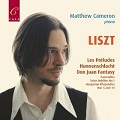 I
very much enjoyed listening to a recording recently which included pieces
composed by pianist Matthew Cameron, as well as music by Chopin and
Liszt and arrangements of some well-known orchestral pieces. The current
recording consists entirely of music and transcriptions by Liszt as
well as transcriptions by Cameron himself. He begins this new recording
with the Fantasy on Don Juan by Lisztafter Mozart. He
presents us with a suitably powerful and majestic opening and soon Cameron
displays his virtuosity to great effect. However he also plays with
great delicacy and lightness when required and successfully portrays
the ever-changing moods in this lengthy piece.
I
very much enjoyed listening to a recording recently which included pieces
composed by pianist Matthew Cameron, as well as music by Chopin and
Liszt and arrangements of some well-known orchestral pieces. The current
recording consists entirely of music and transcriptions by Liszt as
well as transcriptions by Cameron himself. He begins this new recording
with the Fantasy on Don Juan by Lisztafter Mozart. He
presents us with a suitably powerful and majestic opening and soon Cameron
displays his virtuosity to great effect. However he also plays with
great delicacy and lightness when required and successfully portrays
the ever-changing moods in this lengthy piece.
Matthew Cameron plays the opening Andante sostenuto of Hungarian
Rhapsody No.13 very affectingly and with plenty of expression and feeling
for the style. I am not sure about the substantial cut he makes, at
least according to the editions at my disposal, but maybe Cameron feels
the piece otherwise would seem too long to maintain interest. Cameron
demonstrates his virtuosity in brilliant decorative flourishes with
crystal clear demisemiquavers, and these fiendishly difficult passages
seem to hold no fear for him. In the end, they are only decorations
of the melody. One of my favourite recordings of this piece is by Misha
Dichter (Philips Duo) who seems to make all the virtuoso sections become
part of the structure and melodic line. Dichter is fractionally slower
than Cameron in the concluding vivace. Although Cameron’s virtuosity
here is thrilling to hear, I did feel that Dichter’s fractionally slower
tempo allowed the music to breathe and to give us more time to feel
the shape of the musical phrases. Also Dichter makes no cuts but he
adds the occasional short, but effective embellishments. However Matthew
Cameron’s performance is thrilling and exciting and we want plenty of
that in music by Liszt.
Funérailles from Harmonies poétiques et religieuses begins
in sombre mood and Matthew Cameron captures well the tragic tones of
this music. He plays the opening Adagio very slowly indeed, and
his performance of this work is as much as two and a half minutes longer
than some, but he nevertheless manages to maintain the interest and
intensity throughout. He phrases beautifully and the sound is well-balanced.
The recording is excellent and well able to cope with the huge climaxes
achieved by the pianist. Once again I noticed a few minor textural differences,
and I wondered why Cameron sometimes releases the pedal earlier than
marked thus breaking the melodic line in some tied notes.
Jorge Bolet on Decca also gives a fine performance, a little quicker
and more flowing in the slow sections. I like Bolet’s clarity in the poco a poco piu moto where he never allows the left hand quavers
to drown the right hand even in the grandest fortissimo, something
Cameron does in a couple of bars. Misha Dichter colours and phrases
these left-hand triplet quavers brilliantly. Arnaldo Cohen on BIS also
moves forward more than Cameron in the opening Adagio. He is
also more concerned than Cameron to bring out the melody in this section,
but too much so at the expense of the balancing of the chords. That
said, Cohen always makes the piano sing and gives a superb reading,
though some may find the recording a touch cavernous.
Hungarian Rhapsody No.5 is given a rather quick introduction for a piece
marked Lento con duolo. I am not sure that Cameron quite captures
the mood here and the sense of line does not always follow through.
For example the long G in bar 1 seems to disappear as the pedal is perhaps
half released. In the expresso assai section which soon follows,
the tied crotchets are not joined to the ensuing notes thus breaking
the melodic line. The pedalling sounds a little blurry in the semiquavers
at the end of bar 2 and similar, and I also felt that the first crescendo
is built too quickly and it reaches a climax too soon. Sometimes I would
like to hear a greater distinction between semiquavers and demisemiquavers
and I am wondering why on one occasion Cameron plays semiquavers as
triplets. Just before the final section, he continues to play triplet
quavers where ordinary quavers followed by crotchets are written. Again,
he makes a cut. Maybe Matthew Cameron has a more up to date edition
than those available to me, but Balint Vazsonyi on Vox gives a totally
accurate reading rhythmically, at least according to my sources. Also
Vazsonyi maintains a beautiful sostenuto and sense of line in
the second main theme. There is a feeling of organic growth throughout
and he gives a convincing performance although the recording is not
quite top of the class. Jenö Jandó on Naxos is also very accurate with
his rhythms but when he reaches the G major section this can hardly
be described as dolcissimo. I find Jandó too fast and loud here,
but the powerful sections are built superbly. But there is no disputing
that Matthew Cameron, in spite of my minor niggles, gives a thrilling
performance which is well worth hearing.
Liszt asked conductors to make sure that in the tempestuous opening
section of Hunnenschlacht or the Battle of the Huns, brilliantly
transcribed here for piano solo by Matthew Cameron, the colours must
be kept dark and ghostly. In the fearsome opening section, Cameron displays
his phenomenal virtuosity to great effect with dark and deep sounds
to terrify us all.
Valse Oubliée is a nostalgic little piece and it is given an
attractive and characterful performance. The recording at the start
sounds a bit dry but I like Matthew Cameron’s phrasing and subtle pedalling
here. To hear a different approach to this piece, listen to Clifford
Curzon on Decca who gives us a faster, lighter and mostly pedal-free
first section.
In Les Préludes the mood is convincingly set right from the start.
Cameron’s arrangement and performance is very effective and the opening
section builds to an exciting climax and then more lyrical music follows.
Liszt himself made a transcription of this work for two pianos but Matthew
Cameron’s version is equally successful, very virtuosic and exciting.
Cameron’s transcription is sensitively realised and he successfully
conveys the drama and intensity of the work.
This collection is very varied and exciting and although there are already
many fine recordings of some of the pieces presented here, Matthew Cameron
puts his own distinguished stamp on the proceedings. He demonstrates
such fine musicianship and virtuosity, and this excellent project is
really well worth hearing.
Geoffrey Molyneux
Johannes BRAHMS (1833-1897)
Piano Concerto No.1 in d minor, Op.15 [49:02]
Piano Concerto No.2 in B-flat, Op.83 [48:51]
Stephen Hough (piano)
Salzburg Mozarteum Orchestra/Mark Wigglesworth – rec. January 2013.
DDD.
pdf booklet included
2 CDs for the price of one
HYPERION CDA67961 [49:02 + 48:51] – from hyperion-records.co.uk (mp3, 16- and 24-bit lossless)
(See also DL
News 2013/17)
Comparative version:
Hélène Grimaud; Symphonieorchester des Bayerischen Rundfunks (Concerto
1)
Wiener Philharmoniker (Concerto 2)
Andris Nelsons (DG 4791058, 2 CDs, mid-price: Recording
of the Month – review)
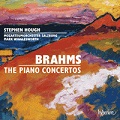 The
Salzburg orchestra is truly menacing at the beginning of Stephen Hough’s
performance of Brahms Piano Concerto No.1. The horns, violas, bass(es)
and timpani attack the opening D with a ferocious fortissimo.I
am used to hearing the orchestral introduction, marked maestoso taken in a rather more drawn out way in the old Romantic tradition.
By contrast, this is lithe and rhythmical with momentum and makes for
a refreshing change. A bit further on the strings play a new theme marked
by the composer to be played softly with expression, and they play here
with great delicacy and refinement. The Bavarian Radio Symphony Orchestra
presents a more full-bodied, richer sound for Hélène Grimaud and Andris
Nelsons on DG. They are a fraction slower than Stephen Hough and Mark
Wigglesworth and their attack is more mellow and less biting. Hough
plays with great eloquence and musicality and he builds the concluding
climax magnificently.
The
Salzburg orchestra is truly menacing at the beginning of Stephen Hough’s
performance of Brahms Piano Concerto No.1. The horns, violas, bass(es)
and timpani attack the opening D with a ferocious fortissimo.I
am used to hearing the orchestral introduction, marked maestoso taken in a rather more drawn out way in the old Romantic tradition.
By contrast, this is lithe and rhythmical with momentum and makes for
a refreshing change. A bit further on the strings play a new theme marked
by the composer to be played softly with expression, and they play here
with great delicacy and refinement. The Bavarian Radio Symphony Orchestra
presents a more full-bodied, richer sound for Hélène Grimaud and Andris
Nelsons on DG. They are a fraction slower than Stephen Hough and Mark
Wigglesworth and their attack is more mellow and less biting. Hough
plays with great eloquence and musicality and he builds the concluding
climax magnificently.
Grimaud’s orchestra makes a fabulous, opulent sound at the beginning
of the Adagio (slowly) second movement and there is some very
intense playing here. Grimaud is heartfelt and passionate in this music.
There seems to be a touch of background noise during Grimaud’s solos;
maybe it is her breathing but this is not too obtrusive. Hough and Wigglesworth’s Adagio feels more like an Andante and they set a very
different mood. The intensity and passion have gone to some extent and
this is no longer the Brahms to which we are accustomed, but there is
a feeling of forward movement and flow and very expressive playing from
all concerned. Stephen Hough’s playing is beautifully phrased and nuanced.
I could grow to like this way of playing Brahms.
In the concluding Rondo, Hough and his orchestra play spiritedly
with fire and energy. There is always great clarity in the texture,
for example in the strings fugato episode, but the tone does
sound a bit thin here. Being a niggly person sometimes, I did not notice
one wind chord not quite in perfect tune, and at the beginning of the Tempo 1 just before the end, the horn figures (first horn 1 followed
by horn 2) are more or less inaudible due to the overloud piano trill.
I prefer Grimaud’s sense of direction, fuller sound and lively excitement
at the beginning of the Rondo, but there is a curious balancing
when the strings take over the main theme. This is all but drowned by
Grimaud’s semiquaver accompaniment … enough niggling. This is a great
performance, truly spectacular. The playing of the orchestra and soloist
is stunning.
Unusually the opening of Piano Concerto No.2 has more of a sense of Allegro, as marked by Brahms in Stephen Hough’s performance.
We are used to hearing this horn melody beautifully played, and this
usually means rather drawn out, sostenuto and held back thus
allowing the horn player the opportunity to demonstrate his beautiful
tone. Hélène Grimaud’s horn player is an example of that, although she
herself changes gear a bit and starts to move forward at her first entry.
The first statement of the main theme both by Hough and later by the
full orchestra does not have the attack or sense of power with which
we are accustomed and the strings sound comparatively lean. Steven Hough
also sounds a bit underpowered sometimes, but I think the performers
are saving themselves for the fortissimo later and the huge climax
as we approach the conclusion of the exposition. At this point Grimaud
and her orchestra are filled with so much fire and passion that I think
she wins hands down. The horn playing is outstanding in the Vienna Philharmonic
at the beginning of the development, with a slight pungency combined
with tonal beauty. The most striking feature of Stephen Hough’s performance
is the beauty of the playing and the lightness of touch. For example
at the beginning of the recapitulation the delicacy of the piano playing
and the gentle wind chording is to be admired for its beauty.
Grimaud begins the allegro appassionato with plenty of fire and
passion. Her power here is amazing, although I think that Nelsons slows
down too much for the second subject which almost comes to a halt, but
the movement builds to a thrilling and passionate climax. Hough makes
an arresting start to this movement. There is much clarity and forward
thrust in his performance and I prefer Wigglesworth’s conducting of
the second subject which he keeps moving well. This is a fine performance,
and like Grimaud, Hough provides a superb climax.
Hough and Wigglesworth present the third movement as a real andante with a feeling of forward movement and never too slow. In fact when
we reach the forte it feels a bit rushed. The opening cello solo
is beautifully played and accompanied with lovely textures in the orchestra.
All is captured superbly on this Hyperion recording. Grimaud’s conductor
is a little slower, and the opening cello melody more dreamy but less
characterful than the Mozarteum orchestra’s player. At the forte Grimaud and Nelsons maintain the tempo although they speed up a little
further on. I prefer the cello soloist, the greater clarity and beautifully
balanced colours of Hough’s recording, as well as his and Wigglesworth’s
sense of forward movement. Hough’s subtlety of phrasing and expression
here is unsurpassed, and the orchestral soloists, as well as the cello
playing are outstanding.
Hough and Wigglesworth are beautifully light and airy in the Finale
and they play here with great delicacy. Once again the orchestral soloists
are exquisite and all is beautifully balanced. The playing is outstanding,
so delicate and refined where necessary and it is all backed up by a
great recording. The sections of the movement are well integrated by
Hough’s subtle sense of rubato. There is always a sense of forward
movement and thrust.
In short Hough is more classical in his approach than Grimaud who gives
a full-blooded, truly Romantic style account and is just a little slower
in the slow movements. The tempi are much the same in the other movements.
Grimaud’s tone can be massive or delicate as required and her orchestras
are superior to Hough’s. The Hyperion recording has greater clarity
and allows every refinement in Hough’s playing to be really appreciated.
If I were forced to choose between the two I would probably go for Grimaud,
but fortunately I now have both of these great performances in my collection
alongside my benchmark recording by Gilels, Jochum and the Berlin Philharmonic
Orchestra. Both are outstanding.
Geoffrey Molyneux
Modest MUSSORGSKY (1839-1881) Pictures from an Exhibition (piano version) [35:47]
Sergei PROKOFIEV (1891-1953) Visions Fugitives, Op.22
[10:35]
Sarcasms, Op.17 [19:36]
Steven Osborne (piano)
pdf booklet included
HYPERION CDA67896 [65:58] – from hyperion-records.co.uk (mp3, 16- and 24-bit lossless)
 Mussorgsky’s
oft-recorded work is heard here in a new recording by Steven Osborne
from Hyperion. The first Promenade is given in a forthright,
no-nonsense way by the pianist and Gnomus also has a minimum
of rubato, but great clarity and control. I particularly like
the soft sections which sounded really mysterious. Il vecchio Castello is played really musically but maybe a touch more feeling of romance
would not come amiss! Tuileries is fast and fleeting and Bydlo begins with a magnificent fortissimo; the sense of struggle as
the oxen try to pull the oxcart to the summit of the hill is well portrayed.
Osborne produces a wonderful, sonorous tone, never forced and always
beautiful however loudly he plays. The next Promenade comes as
a quiet relief after the tension created in Bydlo. Ballet
de Poussins dans leurs coques is played and recorded with crystal
clarity. I particularly like the refinement of the trill playing here.
Mussorgsky’s
oft-recorded work is heard here in a new recording by Steven Osborne
from Hyperion. The first Promenade is given in a forthright,
no-nonsense way by the pianist and Gnomus also has a minimum
of rubato, but great clarity and control. I particularly like
the soft sections which sounded really mysterious. Il vecchio Castello is played really musically but maybe a touch more feeling of romance
would not come amiss! Tuileries is fast and fleeting and Bydlo begins with a magnificent fortissimo; the sense of struggle as
the oxen try to pull the oxcart to the summit of the hill is well portrayed.
Osborne produces a wonderful, sonorous tone, never forced and always
beautiful however loudly he plays. The next Promenade comes as
a quiet relief after the tension created in Bydlo. Ballet
de Poussins dans leurs coques is played and recorded with crystal
clarity. I particularly like the refinement of the trill playing here.
The hustle and bustle of the market place Limoges, Le marché is
vividly characterised by Osborne and this leads directly into Catacombæ played with subtle balancing of chords and extremes of dynamic contrast.
It is difficult to forget Ravel’s orchestration at points like this,
but Steven Osborne is totally convincing in this piece. He gives a lovely pianissimo at the start of Con mortuis in lingua mortua which
is played with the utmost delicacy and sensitivity. La cabane de
Baba-Yaga sur des pattes de poule reminds us of our pianist’s faultless
technique and virtuosity. Always fiery and exciting! Then we move directly
into the elegant first statement of La grande Porte de Kiev which
can sound a bit of an anticlimax in some pianists’ hands, but Osborne
is magnificent here. Later his octaves are sonorous and clear and he
brings the work to a magnificent climax. I always feel that this is
a really difficult work to bring off in its original piano version but
Steven Osborne’s performance is very good and the Hyperion recording
amazing.
Some months ago I wrote a review of Nicolai Demidenko’s performance,
also on Hyperion. Although I found this very fine, I made comparisons
with many other performances and I still feel that Lazar Berman’s account
on DG from 1979 is the best with Richter as second choice. The trouble
with Osborne’s performance is that there is little sense of romance
and whilst the ferocious movements are phenomenally played, performances
sometimes sound too calculated with little sense of danger. The recording
by Hyperion is wonderful and couldn’t be bettered.
A great idea to follow this with some of Prokofiev’s astringent dissonance.
The first of the Sarcasms is truly tempestuous in Steven Osborne’s
hands, and the other fast movements are also thrillingly played. These
miniatures provide a good contrast to the large scale Mussorgsky work
and this strikes me as being good programme building. There is a lovely
and subtle balancing of textures towards the conclusion of Smanioso, and the pianist’s lyrical style is well demonstrated.
The first piece of Visions Fugitives seems simple but with an
underlying feeling of melancholy and Osborne captures the style instantly.
Many of these pieces are easy to play compared with what we have already
heard. But in No.4 we are back to virtuosic semiquavers, played here
as we would expect from Osborne with the utmost clarity. What a strange
ending this piece has and indeed all these short miniatures in the collection
have real musical interest and unexpected turns of phrase. No.7 is particularly
attractive with its unusual textures and spread chords. The direction Pittoresco is subtly observed by Osborne and this is just one
of many unusual and sometimes humorous performance directions given
by the composer. Osborne characterfully portrays No.10 Ridicolosamente and what a funny little gem is No.13 Allegretto. No.14 Feroce brings us back to the aggressive style that so often characterises
Prokofiev’s music. Listen to the extraordinary textures in No.16 Dolente and No.17 Poetico, and the tenderness of No. 18. Steven
Osborne plays the final piece beautifully. He is always able to change
the mood for each successive piece in this collection quickly and easily
and I can’t imagine hearing these Prokofiev works better played.
This is a very fine release and well worth hearing. It is welcome for
its performances, particularly of the works by Prokofiev and these are
the highlights for me. However, for the reasons already mentioned this
would not be my first choice for the Mussorgsky. The quality of Hyperion’s
recording is outstanding and David Fanning’s programme notes are excellent.
Geoffrey Molyneux
Jean SIBELIUS (1865 – 1957)
Concerto for Violin and Orchestra in d minor, Op.47* [31:55]
Karelia Suite, Op.11** [15:51]
Tuonelan joutsen (The Swan of Tuonela), Op. 22/2**/*** [8:16]
Valse lyrique, Op. 96a [4:09]
Valse triste, Op. 44/1 [5:03]
Andante festivo, JS 34b [4:06]
Finlandia, Op. 26 [8:16]
Jennifer Pike (violin)*; Hege Sellevåg (cor anglais)**; Jonathan Aasgaard
(cello)***
Bergen Philharmonic Orchestra/Sir Andrew Davis – rec. June 2013. DDD/DSD
CHANDOS CHAN5134 [78:24] – from theclassicalshop.net (mp3, 16- and 24-bit lossless)
Also available on SACD, CHSA5134
 With
my benchmark recordings in my head – Kyung-Wha Chung/André Previn (Decca
– March
2010 DL Roundup; ignore passionato link – download from 7digital.com)
and Leonidas Kavakos/Osmo Vänskä (BIS, original and revised versions
– review and review)
– in my head, as I thought, the opening movement of the Violin Concerto
in this new recording seemed rather languid and lacking in energy. My
impression was somewhat akin to listening to just about any recording
of the first movement of the Brahms Violin Concerto after hearing Heifetz
and Reiner (RCA),
yet the stopwatch tells a different story: at 15:46 the new recording
is only marginally slower than Chung/Previn and considerably faster
than Kavakos/Vänskä.
With
my benchmark recordings in my head – Kyung-Wha Chung/André Previn (Decca
– March
2010 DL Roundup; ignore passionato link – download from 7digital.com)
and Leonidas Kavakos/Osmo Vänskä (BIS, original and revised versions
– review and review)
– in my head, as I thought, the opening movement of the Violin Concerto
in this new recording seemed rather languid and lacking in energy. My
impression was somewhat akin to listening to just about any recording
of the first movement of the Brahms Violin Concerto after hearing Heifetz
and Reiner (RCA),
yet the stopwatch tells a different story: at 15:46 the new recording
is only marginally slower than Chung/Previn and considerably faster
than Kavakos/Vänskä.
Jennifer Pike and Andrew Davis almost exactly match the tempo of another
recording which I like: Akiko Suwanai and Sakari Oramo with the CBSO,
not generally available in the UK except as an expensive import but
available for download in 24-bit 
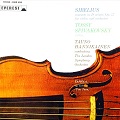 sound
from Linn – DL
News 2012/23. So maybe it’s not these more recent recordings that
lie in my unconscious but Tossy Spivakovsky and Tauno Hannikainen with
the LSO (Everest, available for 24-bit download from HD
Tracks), whose time of 14:42 – and sheer energy – undercuts all
the versions that I checked out yet doesn’t sound rushed. In the case
of Suwanai/Oramo it may be the extra-full sound of the 24/96 transfer
that contributes to my preference – the Chandos was, surprisingly, available
only in 16-bit sound when I obtained it, though 24-bit alternatives
have now been added – but I listened to Spivakovsky/Hannikainen (also
on Magdalen) in a streamed version which I received for review,
to Chung/Previn in mp3 and on CD, and to Kavakos/Vänskä in 16-bit, so
that’s not the whole answer.
sound
from Linn – DL
News 2012/23. So maybe it’s not these more recent recordings that
lie in my unconscious but Tossy Spivakovsky and Tauno Hannikainen with
the LSO (Everest, available for 24-bit download from HD
Tracks), whose time of 14:42 – and sheer energy – undercuts all
the versions that I checked out yet doesn’t sound rushed. In the case
of Suwanai/Oramo it may be the extra-full sound of the 24/96 transfer
that contributes to my preference – the Chandos was, surprisingly, available
only in 16-bit sound when I obtained it, though 24-bit alternatives
have now been added – but I listened to Spivakovsky/Hannikainen (also
on Magdalen) in a streamed version which I received for review,
to Chung/Previn in mp3 and on CD, and to Kavakos/Vänskä in 16-bit, so
that’s not the whole answer.
If you like to hear the lyrical side of Sibelius stressed, you will
probably be happy with the new Chandos, but my own preference lies with
Suwanai/Oramo and Spivakovsly/Hannikainen, with the extra stipulation
that Kavakos and Vänskä on BIS are indispensable if you wish to hear
both the original and ‘regular’ versions.
Carl NIELSEN (1865–1931)
Symphony No.4, Op.29: Det uudslukkelige (FS76) (The Inextinguishable)
[35:15]
Symphony No.5, Op.50 (FS97) [33:50]
Royal Stockholm Philharmonic Orchestra/Sakari Oramo
pdf booklet included
BIS-SACD-2028 [69:46] – from eclassical.com (mp3, 16- and 24-bit lossless)
Benchmark recordings:
• Symphony No.4: BEULAH 1BX161: Danish State Radio
SO/Thomas Jensen – rec.1951 ADD/mono [33:15] – see DL
Roundup August 2011/1.
• Symphonies Nos. 4-6: DOUBLE DECCA 4609882: San
Francisco SO/Herbert Blomstedt (+ Hymnus Amoris [2:21:21] – from 7digital.com:
see DL
Roundup April 2012/1
• Symphony No.5: NAXOS CLASSICAL ARCHIVES 9.80541:
Danish State Radio SO/Jensen [38:40] (+ Maskarade Overture) –
rec.1954. ADD/mono [42:35] – from eclassical.com (mp3 and lossless) or classicsonline.com (mp3) or stream from Naxos
Music Library
• Symphonies Nos. 5 and 6: BMG/RCA 74321202932 (no
longer available): Royal Danish Orchestra/Paavo Berglund – rec.1988/89
DDD [69:05]
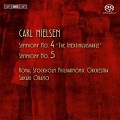 The
two Jensen recordings inevitably sound dated, though Dutton,
Beulah and Naxos have done very well to make them sound more than tolerable,
especially as the Naxos is available in a lossless transfer from eclassical.com.
More to the point, they have never been bettered as performances, not
even by the Blomstedt recording which I’ve listed, though that remains
the prime recommendation among recent recordings and it’s available
very inexpensively on a Decca twofer (around £10 on CD, around £7.50
as a download). The Beulah is a remarkable bargain at £2 and the Naxos
even costs a penny less in mp3 from classicsonline.com, though I’d be
inclined to pay a little more ($7.67) for the lossless version from
eclassical.com. Surprisingly the Berglund remains out of the catalogue
– surely the time is ripe for a reissue.
The
two Jensen recordings inevitably sound dated, though Dutton,
Beulah and Naxos have done very well to make them sound more than tolerable,
especially as the Naxos is available in a lossless transfer from eclassical.com.
More to the point, they have never been bettered as performances, not
even by the Blomstedt recording which I’ve listed, though that remains
the prime recommendation among recent recordings and it’s available
very inexpensively on a Decca twofer (around £10 on CD, around £7.50
as a download). The Beulah is a remarkable bargain at £2 and the Naxos
even costs a penny less in mp3 from classicsonline.com, though I’d be
inclined to pay a little more ($7.67) for the lossless version from
eclassical.com. Surprisingly the Berglund remains out of the catalogue
– surely the time is ripe for a reissue.
One other highly-regarded recording which I must mention, though it’s
a long time since I heard it, comes from the LSO and Schmidt, another
bargain on the Alto label (ALC1236) and available direct from MusicWeb
International for £5.99. See review.
Against those benchmarks the obvious advantage of the Sakari Oramo recording
is the fact that it was recorded digitally and is available as an SACD
and as an impressive-sounding 24-bit download. I tried the mp3 and that’s
very good of its kind, too, so you may hesitate to pay a 50% premium
for 24-bit ($16.73) over the 16-bit, which comes at the same very reasonably
price as the mp3 ($10.46).
But it’s the lesson that the benchmarks teach us about performance style
that’s vitally important, namely that it’s easy to capture the power
that’s abundantly present in both these symphonies but that the real
trick is to get the right mix of power and repose, of drama and reflection.
Not surprisingly in view of his performance of No.4 at the 2011 Proms,
Oramo fits the bill in both respects and I very much look forward to
further instalments of what looks like being a complete series. Don’t
throw out Jensen, Blomstedt or Berglund, but this could well be the
new benchmark.
If it matters – perhaps to teachers and lecturers seeking to play examples
– the new BIS recording, like the Naxos, divides the Fifth into just
two tracks, whereas Decca make six tracks out of it: more convenient
for finding examples, but even Winamp creates a minuscule pause between
some of the tracks where the music is continuous.
Manuel de FALLA (1876-1946)
El sombrero de tres picos (The three-cornered hat): Suites 1
and 2 [40:10]
Noches en los jardines de España (Nights in the Gardens of Spain)
G49 [24:57]
Josep Colom (piano)
Orquesta Ciudad de Granada/Josep Pons – rec. c.1996. DDD/DSD
HARMONIA MUNDI HMC901606 [65:07] – from eclassical.com (mp3 and lossless) or stream from Naxos Music Library
Federico García LORCA (1898-1936) Canciones españolas antiguas (Old Spanish Songs)* [26:10]
Manuel de FALLA El Corregidor y la Molinera (The Official
and the Miller’s Wife)** [45:17]
Ginesa Ortega Cortés (singer)*; Olga Serra (soprano)**
Orquestra de Cambra Teatre Lliure/Josep Pons – rec. c.1995. DDD
HARMONIA MUNDI HMA1951520 [71:27] – from eclassical.com (mp3 and lossless) or stream from Naxos Music Library

 With
these two releases we have Spanish performances of Falla’s El sombrero
de tres picos – the two suites – and its less well-known original
form, El Corregidor y la Molinera in which most of the familiar
music appears but not always in familiar guise. On the second album El Corregidor is coupled with Lorca’s settings of songs from
the late medieval and early modern periods.
With
these two releases we have Spanish performances of Falla’s El sombrero
de tres picos – the two suites – and its less well-known original
form, El Corregidor y la Molinera in which most of the familiar
music appears but not always in familiar guise. On the second album El Corregidor is coupled with Lorca’s settings of songs from
the late medieval and early modern periods.
The first album is deleted on CD, presumably because in 2011 Josep Pons
made a later recording of Noches en los Jardines* with Javier
Peranes and the BBCSO, and ridiculously high prices are being asked
for it, so its availability as a download is very welcome, especially
as the performances of both works are good and well recorded.
The recording of El Corregidor is less easily recommendable:
the parent CD is still available for around £6-7, slightly less than
the cost of the download. There are no texts, but Harmonia Mundi are
notoriously mean about providing these with the budget reissues, so
there may be none with the CD either – a pity since the words are hardly
familiar. I was able to recognise only Las Morillas de Jaén,
based on a 15th-century song about three converted Moorish
girls who love the poet: Tres moricas me enamoran / en Jaén: / Axa
y Fátima y Marién.
Ginesa Ortega Cortés sings the music in flamenco style, no doubt more
‘authentic’ than Victoria de los Angeles (EMI Icons, 7 CDs) but some
may find it off-putting – try first from Naxos Music Library if you
can. The music has been orchestrated and, in some cases, the texts have
been abridged.** Whatever your reaction – and I was put off by the singing
of the Lorca – the recording is well worth having for the familiar yet
unfamiliar version of the Falla ballet, which is available separately
for $8.15.
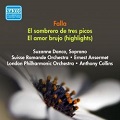
The 1952 recording of El sombrero de tres picos (Suzanne Danco,
soprano, OSR/Ernest Ansermet) inevitably sounds rather dry but has come
up sounding surprisingly well in a Naxos Classical Archives transfer,
coupled with a shrill but tolerable transfer of the LPO/Anthony Collins
1950 recording of El amor brujo. It’s available very inexpensively
from classicsonline.com but, so good is the transfer, belying the original
review which described it as suffering from ‘LP pinch’, I’d recommend
paying a little more for the lossless version from eclassical.com.
(980466). The information was clearly all in the grooves but
the cartridges of the time couldn’t process it.
I’d just finished writing this review and was about to close this DL
News when I received Beulah release:
The Art of Spain: Volume 2
Manuel de FALLA Noches en los jardines de España (Nights
in the Gardens of Spain) G49 [22:35]
Gonzalo Soriano (piano); National Orchestra of Spain/Ataúlfo Argenta
– rec. 1957. ADD
Joaquín RODRIGO (1901-1999) Concierto de Aranjuez [21:17]
Narciso Yepes (guitar); National Orchestra of Spain/Ataúlfo Argenta
– rec. 1957. ADD
Joaquín TURINA (1882-1949) Danzas fantásticas [16:59]
Paris Conservatoire Orchestra/Rafael Frühbeck de Burgos – rec.1962.
ADD
BEULAH 2PD88 [60:52] – coming soon from iTunes and Amazon
 There
are two classic performances here – the two concertante works,
originally released on Decca SXL2091 – and one very enjoyable filler,
all in transfers that belie their age. Various inexpensive transfers
exist of the two recordings with Argenta, but I think some of them are
actually of the earlier mono recordings with the Madrid orchestra and
I can’t imagine that any of them come close to the quality of sound
which Beulah have achieved.
There
are two classic performances here – the two concertante works,
originally released on Decca SXL2091 – and one very enjoyable filler,
all in transfers that belie their age. Various inexpensive transfers
exist of the two recordings with Argenta, but I think some of them are
actually of the earlier mono recordings with the Madrid orchestra and
I can’t imagine that any of them come close to the quality of sound
which Beulah have achieved.
The Soriano/Argenta recording of Noches en los jardines remains
a prime recommendation even in the face of Soriano’s own later recording
with the Paris Conservatoire Orchestra and Frühbeck de Burgos, now available
only in a 16-CD set, though the single-disc release with El Amor
brujo (de los Angeles and Giulini) remains available to download.
Much as one might bemoan the fact that Rodrigo’s other concertos seldom
get a look in, it must be admitted that the Concierto de Aranjuez is music with a very strong appeal. Narciso Yepes, who recorded it several
times, has always been one of its prime advocates and this recording
can stand its own against the later DG versions, at least two of which
remain available on CD. Yepes’ guitar seems to fill the whole soundstage
in a larger-than-life fashion but that’s my only reservation about any
of the transfers, and it’s hardly a fault that can be laid at Beulah’s
door.
There’s only one recording of similar, slightly later vintage of the
Rodrigo to equal the Yepes and that’s the Julian Bream recording with
Sir John Eliot Gardiner, now available again in its original 1975 coupling
with the Lennox Berkeley Guitar Concerto for just £3.99 from iTunes.
Similarly, there’s only one vintage recording of Noches en los jardines
de España to rival the Soriano and Argenta and that’s Alicia de
Larrocha and Rafael Frühbeck de Burgos on a Double Decca 2-for-1 bargain
(4661282: The Essential Falla – download from 7digital.com).
I was slightly underwhelmed by the recent Chandos recording of El
sombrero de tres picos and Noches en los jardines de España on CHAN10694 (Bavouzet and Mena), but I liked their mid-price El amor brujo and Noches on CHAN8904 (Fingerhut
and Tortelier) – see DL
Roundup February 2012/2. A 24-bit version of CHAN10694 has been
added since I wrote that review.
At the time of writing the Beulah reissue had yet to appear from iTunes
or Amazon but precedent suggests that it will be available at a price
attractive enough, around £7.50, to recommend snapping it up.
It’s been pointed out to me that the Beulah reissue of the Chalabala
recording of The Bartered Bride which I reviewed in 2014/1 is
also available for download from Supraphon, at a competitive price and
re-mastered from the original tapes – here.
You do, however, require a greater degree of fluency in Czech than I
possess.
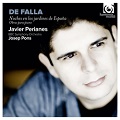
* HMC902099: eclassical.com have that, too, and in 24-bit format as well as mp3 and 16-bit lossless,
albeit at a premium price of $21.45 (mp3 and 16-bit a much more reasonable,
indeed competitive $14.30). Noches en los jardines is coupled
with other music by Falla in texts which have been revised from authentic
sources. This time the pdf booklet is part of the deal.
** Urtext offer the original settings with guitar (JBCC053),
available from classicsonline.com and Naxos Music Library. Valentina Alvarez sings just as powerfully
but clearly and without the gypsy-fying which I found somewhat off-putting.
Still no texts with the download, however.
Sándor VERESS (1907-1999) Complete Music for String Quartet
String Quartet No. 1 (1931) [17:25]
String Quartet No. 2 (1937) [29:07]
Concerto for String Quartet and Orchestra (1961) (first recording) [24:50]
Basel String Quartet;
Hungarian Symphony Orchestra/Jan Schultsz – rec. October 2012 and January
2013. DDD
pdf booklet included
TOCCATA CLASSICS TOCC0062 [71:26] – from toccataclassics.com or eclassical.com (mp3 and lossless) or stream from Naxos Music Library. Also available
on CD from MusicWeb International here.
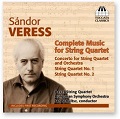 This
being my first encounter with Sándor Veress’s music, I can’t better
Toccata’s own brief introduction to this album: ‘[he] was born in Kolozsvár,
then in Hungary … but spent the last half-century of his life in Switzerland
as an exile from Communism. In the 1930s he worked as Bartók’s research
assistant in his work on Hungarian folksong, with results audible in
the two early string quartets. By the time of the Concerto for String
Quartet and Orchestra three decades later, Veress had developed a lean
and muscular style, incorporating elements of modernism but retaining
a powerful sense of onward momentum, expressed in an original voice
which combines head and heart in an exhilarating blend of freewheeling
invention, fantasy and wit.’
This
being my first encounter with Sándor Veress’s music, I can’t better
Toccata’s own brief introduction to this album: ‘[he] was born in Kolozsvár,
then in Hungary … but spent the last half-century of his life in Switzerland
as an exile from Communism. In the 1930s he worked as Bartók’s research
assistant in his work on Hungarian folksong, with results audible in
the two early string quartets. By the time of the Concerto for String
Quartet and Orchestra three decades later, Veress had developed a lean
and muscular style, incorporating elements of modernism but retaining
a powerful sense of onward momentum, expressed in an original voice
which combines head and heart in an exhilarating blend of freewheeling
invention, fantasy and wit.’
Appropriately his native Hungary and Switzerland, which gave him refuge,
have combined to produce this attractive album of his music, including
a joint offering of the premiere recording of the concerto.
There’s an earlier recording of Veress’s two string quartets from the
Ensemble des Equilibres on Hungaroton, coupled with his string trio
on HCD32691 – review – download from classicsonline.com (mp3) or stream from Naxos Music Library.
The booklet which is provided free to all comers on the Toccata website
is complete; that which eclassical.com offer lacks the rear CD insert
with the important track details and timings.
As I was about to close this DL News, I noted that Jonathan Woolf has
been impressed, too – review.
George LLOYD (1913-1998) Symphonies
Neglected for far too long, George Lloyd’s music at least received some
attention from the record companies towards the end of his life, unlike
poor Havergal Brian – no sooner had he been ‘discovered’ on a BBC TV
programme than he suffered a serious accident and died soon after.
Apart from Symphonies Nos. 4, 5 and 8 from the Philharmonia Orchestra
and Edward Downes on a 3-CD Lyrita set (SRCD.2258 – review, review, review:
download in mp3 from emusic.com*),
Albany Records are the ‘home’ of George Lloyd’s symphonies, in authoritative
performances, mostly with the Albany Symphony Orchestra and all conducted
by the composer himself.
 Though
I’m very happy with that Lyrita set, I’m very pleased to see that High
Definition Tape Transfers have released some HD recordings in 24-bit
sound under licence from Albany. Symphony No.11 (HDDLTroy060 [58:57]) is a powerful work, all the more remarkable for succeeding
the easy-going No.10, November Journeys, which celebrated the
cheap pensioner fares that British Rail used to offer in that month.
No.11 began the Lloyd/Albany relationship in 1986 – the work was specially
commissioned by the president of the Albany orchestra, having heard
a BBC broadcast of the Eighth symphony.
Though
I’m very happy with that Lyrita set, I’m very pleased to see that High
Definition Tape Transfers have released some HD recordings in 24-bit
sound under licence from Albany. Symphony No.11 (HDDLTroy060 [58:57]) is a powerful work, all the more remarkable for succeeding
the easy-going No.10, November Journeys, which celebrated the
cheap pensioner fares that British Rail used to offer in that month.
No.11 began the Lloyd/Albany relationship in 1986 – the work was specially
commissioned by the president of the Albany orchestra, having heard
a BBC broadcast of the Eighth symphony.
The performance is clearly authoritative and the Albany Orchestra is
no makeshift provincial ensemble. Because the original recording was
made in 24/44.1 sound, HDTT have not tried to improve on it so, unusually
for them, playback – from the master tapes rather than a commercial
reel-to-reel tape, as is their wont – is at that setting rather than
24/96 or higher, but it sounds none the worse for it – here.
At current exchange rates HDTT’s $14.00 represents a price advantage
over the UK price of the Albany SACD of around £14. Don’t be deceived
by the ghostly image of the composer on the cover – there’s nothing
feeble about the music – see analysis by Paul Conway – performance or recording.
 The
bookends of Lloyd’s symphonies, Nos. 1 and 12, recorded in 1990, are
coupled on HDDLTroy032 [65:39] – here.
Once again the transfer is at 24/44.1. Here, too, it’s only the image
of the composer on the cover that is at all faded – if anything, this
is an even more important release than that of Symphony No.11. As before,
the music, authoritative performances and recording – no attempt to
make the sound over-bright – make this a desirable purchase and the
price, slightly higher at $16, still compares favourably with the SACD
release.
The
bookends of Lloyd’s symphonies, Nos. 1 and 12, recorded in 1990, are
coupled on HDDLTroy032 [65:39] – here.
Once again the transfer is at 24/44.1. Here, too, it’s only the image
of the composer on the cover that is at all faded – if anything, this
is an even more important release than that of Symphony No.11. As before,
the music, authoritative performances and recording – no attempt to
make the sound over-bright – make this a desirable purchase and the
price, slightly higher at $16, still compares favourably with the SACD
release.
* an inexpensive download but not transferred at an ideal bit rate;
the CDs are available from MusicWeb International, a 3-for-2 offer at
£23 p.p. worldwide – here.
Richard STRAUSS (1914-1949) Salome
Birgit Nilsson (soprano) – Salome
Gerhard Stolze (tenor) – Herod
Grace Hoffman (mezzo) – Herodias
Eberhard Wächter ((baritone) ) – Jokanaan
Waldemar Kmentt (tenor) – Narraboth
Josephine Veasey (mezzo) – Page to Herodias
Paul Kuen (tenor) – First Jew)
Stefan Schwer (tenor) – Second Jew
Kurt Equiluz (tenor) – Third Jew
Aron Gestner (tenor) – Fourth Jew
Max Proebstl (bass) – Fifth Jew
Tom Krause (baritone) – First Nazarene
Nigel Douglas (tenor) – Second Nazarene
Zenon Kosnowski (bass) – First Soldier
Heinz Holecek (bass) – Second Soldier
Theodor Kirschbichler (bass) – Cappadocian
Liselotte Mailk (soprano) – Slave
Wiener Philharmoniker/Sir Georg Solti – rec. c.1961. ADD.
DECCA ORIGINALS 4757528 [2 CDs: 99:19] also available as a Hallmark
download from emusic.com (mp3)
Reiner Goldberg (tenor) - Herod Antipas, Tetrarch of Judea
Anja Silja (soprano) - Herodias, Herod’s wife
Inga Nielsen (soprano) - Salome, Herodias’s daughter
Bent Norup (baritone) - First Nazarene
Per Hoyer (baritone) - First Soldier
Morten Frank Larsen (baritone) - Second Nazarene
Anders Jakobsson (bass) - A Cappadocian
Stephen Milling (bass) - Second Soldier
Sten Byriel (bass-baritone) - Fifth Jew
Robert Hale (bass-baritone) - Jokanaan (John the Baptist)
Marianne Rorholm (mezzo) - Herodias's Page
Henriette Bonde-Hansen (soprano) - A Slave
Gert Henning Jensen (tenor) - First Jew
Peter Gronlund (tenor) - Fourth Jew
Deon van der Walt (tenor) - Narraboth, a young Syrian, Captain of the
Guard
Ole Hedegaard (tenor) - Second Jew
Mikael Kristensen (tenor) - Third Jew
Danish National Radio Symphony Orchestra/Michael Schønwandt – rec. 1998
pdf booklet with texts and translations available
CHANDOS CHAN9611 [2 CDs: 98:58] – from theclassicalshop.net (mp3 and lossless)
 I
downloaded the Hallmark version of the classic Nilsson/Solti recording for a mere £1.68 from emusic.com, sceptical that so inexpensive
a transcription (mp3, at around 225kb/s) could deliver the goods in
the case of a Decca Sonicsound original. I have to say that, although
Decca’s own refurbishment from the master tapes no doubt sounds better,
especially if downloaded in lossless format*, the Hallmark budget version
is to my ears little inferior to what I remember of the full-price LPs
(SET228), as played by a fellow (richer than me) undergrad on state-of-the-art
equipment c.1963. It stands playing at a high level and will benefit
from it.
I
downloaded the Hallmark version of the classic Nilsson/Solti recording for a mere £1.68 from emusic.com, sceptical that so inexpensive
a transcription (mp3, at around 225kb/s) could deliver the goods in
the case of a Decca Sonicsound original. I have to say that, although
Decca’s own refurbishment from the master tapes no doubt sounds better,
especially if downloaded in lossless format*, the Hallmark budget version
is to my ears little inferior to what I remember of the full-price LPs
(SET228), as played by a fellow (richer than me) undergrad on state-of-the-art
equipment c.1963. It stands playing at a high level and will benefit
from it.
The performance remains ‘the one to have’ as Göran Forsling put it – review,
with all the power intact that I remember from fifty years ago. GF made
it a Recording of the Month and it’s not just nostalgia
that makes me regard it as unassailable.
With just four tracks on Hallmark, corresponding to the sides of the
original LPs, you can burn the whole opera to an mp3 CD without any
problem of hiatuses between tracks.
 There’s
no libretto with the Decca download but the Chandos booklet is free
to all comers. More to the point, if you’re looking for a more modern
version in lossless sound, the Schønwandt recording is not far
behind the Solti.
There’s
no libretto with the Decca download but the Chandos booklet is free
to all comers. More to the point, if you’re looking for a more modern
version in lossless sound, the Schønwandt recording is not far
behind the Solti.
You’ll find a detailed analysis of this recording from Dan Morgan in DL
Roundup June 2011/1. On that occasion both Dan and I experienced
some problems downloading so I started from scratch again this time
and experienced no difficulty.
* Available from deutschegrammophon.com in flac for £11.49 – but NB you can find the CD set less expensively
than that, currently for as little as around £8, from some online suppliers.
Freebie of the Month
 James
MACMILLAN (b.1959)
James
MACMILLAN (b.1959)
The World’s Ransoming [22:14]
The Confession of Isobel Gowdie [22:51]
Christine Pendrill (cor anglais); London Symphony Orchestra/Sir Colin
Davis – rec. live 2003 and 2007. DDD/DSD
pdf booklet included
LSO LIVE LSO0124 [45:05] – from theclassicalshop.net (mp3 and lossless)
 This
is the February 2014 free offering, in mp3 format, for subscribers to
the Chandos/theclassicalshop newsletter. There are several other fine
versions of the Confession – purely orchestral despite the title
and MacMillan’s intention that this should be the Requiem that
Isobel Gowdie never had – but none to be had free. Tony Haywood liked
the recording on BIS-CD-1169: Recording of the Month – review:
download from eclassical.com,
mp3 and lossless, with booklet. Even if you’re still not sure about
James MacMillan – his often powerful music is a taste that I’m acquiring
more and more – this is a good opportunity to get to know him. If you
haven’t yet signed up for the newsletter, you’ll have missed this, but
you can join now to enjoy forthcoming freebies.
This
is the February 2014 free offering, in mp3 format, for subscribers to
the Chandos/theclassicalshop newsletter. There are several other fine
versions of the Confession – purely orchestral despite the title
and MacMillan’s intention that this should be the Requiem that
Isobel Gowdie never had – but none to be had free. Tony Haywood liked
the recording on BIS-CD-1169: Recording of the Month – review:
download from eclassical.com,
mp3 and lossless, with booklet. Even if you’re still not sure about
James MacMillan – his often powerful music is a taste that I’m acquiring
more and more – this is a good opportunity to get to know him. If you
haven’t yet signed up for the newsletter, you’ll have missed this, but
you can join now to enjoy forthcoming freebies.
If you are considering buying, I should point out that at £7 (mp3) and
£9 (lossless), the download is rather expensive and that classicsonline.com’s
and 7digital.com’s £7.99 (mp3 only) are even more so: MDT’s normal price
for the CD, £5.40, is currently reduced to £4.50.
Jazz Bargain of the Month
 Charles
Mingus: Complete Recordings 1957-1960
Charles
Mingus: Complete Recordings 1957-1960
Word from Bird [10:09]
Laura [6:09]
Show Time [5:03]
When Your Lover has gone [2:29]
Just One of Those Things [6:01]
Blue Greens [11:39]
Haitian Fight Song [12:03]
Blue Cee [7:58]
Reincarnation of a Lovebird [8:34]
The Clown [12:25]
Yesterdays [4:15]
Back Home Blues [5:31]
I Can’t Get Started [6:31]
Hamp’s New Blues [3:54]
Summertime [4:40]
Dizzy Moods [6:53]
Laura (Three) [6:33]
Memories of You (Take 7) [4:27]
East Coasting (Take 4) [5:12]
West Coast Ghost (Take 6) [8:56]
Celia (Take 5) [7:05]
Conversation (Take 16) [5:28]
Fifty-First Street Blues (Take 4) [5:46]
Scenes in the City [11:55]
Nouroog [4:51]
New York Sketchbook [8:55]
Duke’s Choice [6:27]
Slippers [3:28]
Better Git in Your Soul [7:21]
Goodbye Pork Pie Hat [5:43]
Boogie Stop Shuffle [4:59]
Self-Portrait in Three Colors [3:08]
Open Letter to Duke [5:50]
Bird Calls [6:16]
Fables of Faubus [8:14]
Pussy Cat Dues [9:12]
Jelly Roll [6:16]
Nostalgia in Time Square (Live) [12:18]
I Can’t Get Started (Live) [10:08]
No Private Income Blues (Live) [12:51]
Alice’s Wonderland (Live) [8:54]
Hey (Night) / Too Blue / Ballad of the Fortune Teller [3:13]
Note on the Commercial Theatre [1:35]
The Weary Blues [3:09]
Blues at Dawn [0:51]
Six Bits Blues [1:18]
Morning after [1:27]
Could Be / Bad Luck Card / Bad Man [2:50]
Life Is Fine [2:02]
Hey Hey (Morn) [1:18]
Testament [5:42]
Consider Me [3:19]
Warning / Augmented [1:07]
Motto / Dead in There [2:05]
Final Curve [0:10]
Boogie / 1am [1:51]
Bed Time [1:06]
Daybreak [1:00]
Tell Me [0:39]
Good Morning / Harlem [1:43]
Same In Blues / Comment On Curb [1:45]
Democracy / Island / Extract from Warning / Augmented / Jump Monk [6:07]
Wednesday Night Prayer Meeting [5:43]
Cryin’ Blues [5:02]
Moanin’ [8:02]
Tensions [6:30]
My Jelly Roll Soul [6:50]
E’s Flat, Ah’s Flat Too [6:42]
PLAYTIME [6:17:37] – from iTunes (m4a)

The contents of nine Charles Mingus LP recordings for £3.99 are a real
bargain: you’d pay at least as much or more for each of the classic
1959 albums – the Sony reissue of one album, Ah Um, alone from
iTunes costs £9.99. Moreover, this is only one of such offers, with
similar collections from 1945-56 and 1960-62 available for the same price.
Better still, the sound, transferred at
around 260kb/s, is good, so Mingus fans need not hesitate; even if they
possess some of the tracks already, the rest is eminently worth having
at the price.
